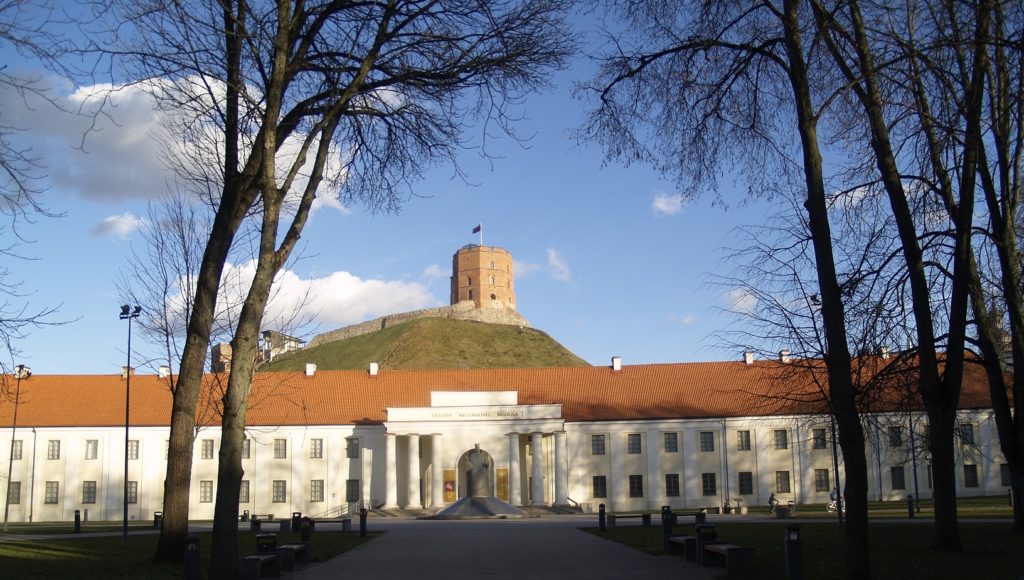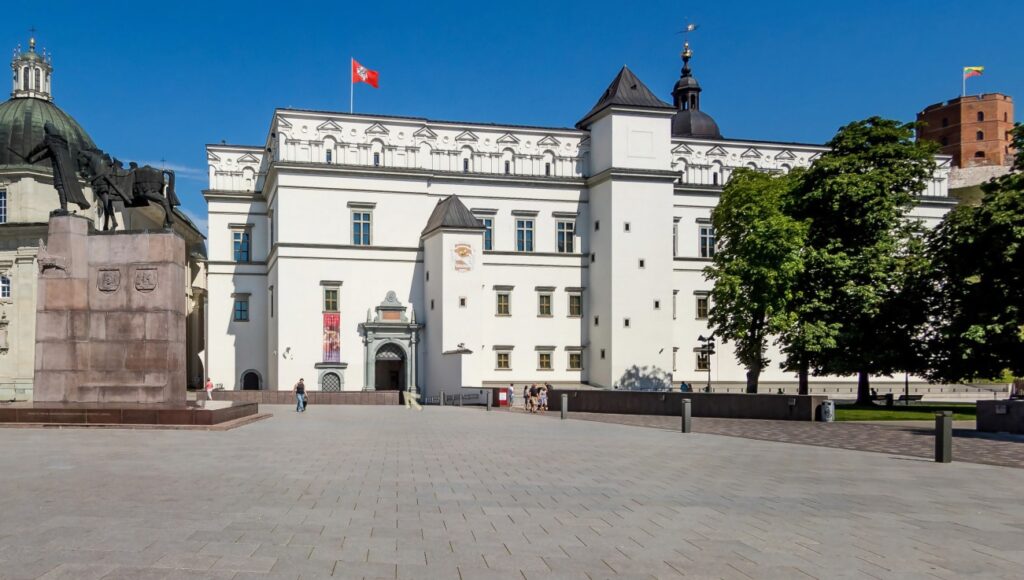VILNIUS CASTLES
Introduction

Vilnius Castles – the heart of all Lithuania, the place where the early Lithuanian state was built and grand dukes lived. The castle tower offers a good view of the Three Crosses – a white monument on the other side of the Vilnia, called the Hill of Three Crosses.
The heart of the city is at the confluence of the Neris and Vilnia rivers. It is also the heart of all Lithuania, the place where the early Lithuanian state was built and grand dukes lived.
Nearby river rises the Gediminas hill with steep 48m high slopes. On its top looms the Higher, or Gediminas Castle, a symbol of Vilnius and Lithuania.
Once the Vilnia had a different riverbed, south and west of the hill, around the present Cathedral Square. Its second riverbed east of the hill was dug out in the late 13th century or early 14th century. In the long run the old riverbed disappeared and only the new one remained, but in the times of Gediminas and his descendants the castle and the Cathedral were situated on a kind of island.
On the other bank of the Vilnia rise several hills bearing the names of Three Crosses, Bekesh, Table and Gediminas’ Grave. In early times there was a timber fortification called the Crooked Castle.
At the foot of the Gediminas Hill stretches the Šventaragis valley. West of the hill is the reconstructed Palace of Grand Dukes of the Lower Castle. The belfry of the Cathedral is built on a defensive tower of the Lower Castle.
THE HIGHER CASTLE and the HILL PARK

The Gediminas Hill is a typical Lithuanian mound, the largest such hill of natural origin in Lithuania.
The Vilnius castle was first mentioned on October 2nd 1323 in Gediminas’ treaty. At that time the Higher Castle was built of timber. Later a brick castle was built.
After the 1419 fire Vytautas rebuilt and fortified it. The castle was surrounded by a stone wall with three towers. During the 1831 uprising, by tsar’s order the Gediminas Hill was turned into part of the Vilnius stronghold.
In 1930 the superstructure was pulled down. The tower was damaged once more during the Second World War, and renovated in 1956-60 to hold a museum. On the tower various occupational powers used to raise their flags. Since 1988 the Lithuanian tricolour is flying there again.
The western tower of the Higher Castle, usually called the Gediminas Tower, has an octagonal plan, stone foundation, and mainly brick walls built in the Gothic manner.
At the Gediminas Tower loom the remnants of the defensive wall. There are more remnants on the hilltop. The bottom segments of the square southern tower and the northern gate have also survived.
The palace had pointed Gothic arches and vaults, its walls were 4m thick. They are interesting not so much from the viewpoint of their architecture, but as a unique historic legacy bearing witness to the earliest epoch of the Lithuanian capital. The first floor with four rooms has survived in quite a good shape.
Three Crosses

The history of the Three Crosses goes back to the times of Algirdas. According to a legend, pagans killed seven Franciscan missionaries in Vilnius. In 1916 architect Antanas Vivulskis built concrete crosses. In 1951 the Soviet authorities blew them up, but in 1989 they were reerected. Today the crosses are taller (by 1.8m) than those designed by Vivulskis. Fragments of the old crosses are displayed nearby.
Farther away looms the Bekesh Hill with steep slopes named after the Hungarian Caspar Bekesh (1520-79), a military leader in the service of Stephen Batory, who was buried there: as an Arian he could not rest in a Catholic cemetery. On Bekesh’s grave an octagonal monument with an inscription was erected, but in 1843 it collapsed, the Vilnia having washed away the slope.
Bekesh Hill
A concrete pavilion, now a landmark of the Bekesh Hill, has nothing in common with this monument. The Hill of Gediminas’ Grave, most probably a mound, can be seen behind the Bekish Hill. According to one tradition points to Veliuona, where he was killed, as his burial place. It is worthwhile climbing the Hills of Three Crosses and Bekesh. A view opening from these hills is no less beautiful than the one from the Gediminas Tower, and perhaps even better, as it allows one to see the Castle Tower itself.
The Crooked Castle apparently stood on the Hill of Three Crosses. There, as well as on the Bekesh Hill, archaeologists have discovered remains of burnt homesteads and 13th and 14th century finds.
THE LOWER CASTLE
The palace at the foot of the Castle Hill was a residence of the Grand Duke. In the 2nd half of the 14th century the palace and other buildings of the Lower Castle were surrounded by a defensive wall with four gates, more than 1km long.
In historical reminiscences the Higher Castle is primarily related with the era of Gediminas, Algirdas and Vytautas. The Lower Castle – with the times of Sigismund the Old and Sigismund August, Queen Bina and Barbora Radvilaitė. In the 16th century it was an Italian-style palace with four wings and attics.
The castle was also damaged during the 1655-61 war with Moscow, and in the early 19th century it was pulled down. After the restoration of Lithuania’s independence, it was suggested that the Palace of Grand Dukes be rebuilt, and despite the ensuing controversy, it was reconstructed in 2002-2009.
THE OLD ARSENAL

The Old Arsenal (Arsenalo St.3,3a) is situated at the Vilnia, in the former territory of the Lower Castle.
A Renaissance attic was built in the late 16th – early 17th century.
The building was damaged during wars of the 17th century, rebuilt in 1780, and burned down at the end of the Second World War.
In 1986 the east wing was restored according to a project by Evaldas Purlys. It houses the Museum of Applied Art. The Old Arsenal enables the visitors to feel the ambience of the Renaissance Vilnius.
THE NEW ARSENAL

In the 14th century, buildings adjoining the defensive wall of the Lower Palace stood on the site of the New Arsenal (Arsenalo St.1).
Later they were connected. Architect Martin Knackfuss rendered some Classical features to the New Arsenal.
The building has retained fragments of its early Gothic vaults and Renaissance brick walls.
In the 19th century the New Arsenal housed soldiers’ barracks. In 1958-65 the building was renovated and converted into a museum. At the present time it holds a permanent exhibition of history and ethnography of the National Museum of Lithuania.
In 2003, a monument to King Mindaugas was erected in the square in front of the building.
INTERACTIVE VILNIUS CASTLES MAP








